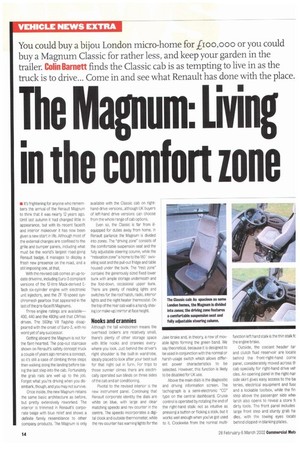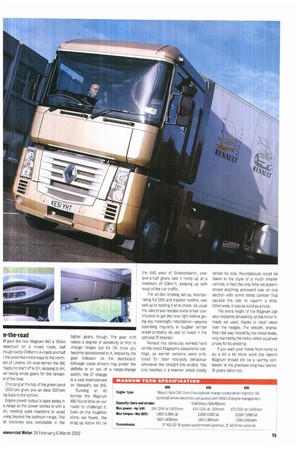The Magnum: Living in the comfort zone
Page 14

Page 15

If you've noticed an error in this article please click here to report it so we can fix it.
You could buy a bijou London micro-home for Doo,000 or you could buy a Magnum Classic for rather less, and keep your garden in the trailer. Colin Barnett finds the Classic cab is as tempting to live in as the truck is to drive... Come in and see what Renault has done with the place.
• Its frightening for anyone who remembers the arrival of the Renault Magnum to think that it was nearly 12 years ago. Until last autumn it had changed little in appearance. but with its recent facelift and interior makeover it has now been given a new start in life. Although most of the external changes are confined to the grille and bumper panels, including what must be the world's largest road-going Renault badge, it manages to display a fresh new presence on the road, and a still imposing one, at that.
With the revised cab comes an up-todate driveline, including Euro-3 compliant versions of the 12-litre Mack-derived ETech six-cylinder engine with electronic unit 'Nectars, and the ZF 16-speed synchromesh gearbox that appeared in the last of the pre-facelift Magnums.
Three engine ratings are available400. 440 and the 480hp unit that CM has driven. The 560hp V8 flagship disappeared with the onset of Euro-3, with no ,.:ord yet of any successor.
Getting aboard the Magnum is not for me faint-hearted. The pop-out staircase shown on Renault's safety concept truck a couple of years ago remains a concept, so it's still a case of climbing three steps then walking along the landing before taking the last step into the cab. Fortunately the grab rails are well up to the job. Forget what you're driving when you disembark, though, and you may not survive.
Once inside, the new Magnum retains the same basic architecture as before, but pretty extensively reworked. The interior is trimmed in Renault's corporate beige with blue relief and shows a definite family resemblance to other company products. The Magnum is only available with the Classic Cab on righthand-drive versions. although UK buyers of left-hand drive versions can choose from the whole range of cab options.
Even so, the Classic is far from illequipped for duties away from home. In Renault parlance the Magnum is divided into zones. The "driving zone" consists of the comfortable suspension seat and the fully adjustable steering column, while the "relaxation zone" is home to the 180 swivelling seat and the pull-out fridge and table housed under the bunk. The "rest zone" contains the generously sized fixed lower bunk with ample storage underneath and the fold-down, occasional upper bunk. There are plenty of reading lights and switches for the roof hatch, radio, interior lights and the night heater thermostat. On the top of the rear cab wall is a handy shaving for make-up) mirror at face height.
Nooks and crannies
Although the tall windscreen means the overhead lockers are relatively small, there's plenty of other storage space with little nooks and crannies everywhere you look. Just behind the driver's right shoulder is the built-in wardrobe. ideally placed to look after your best suit for that night out in Turin. For trips to those sunnier climes there are electrically operated sun blinds on three sides of the cab and air conditioning.
Pivotal to the revised interior is the new instrument panel. Continuing that Renault corporate identity the dials are white on blue, with large and clear matching speedo and rev counter in the centre. The speedo incorporates a digital clock and outside thermometer, while the rev counter has warning lights for the Jake brake and, in theory, a row of movable lights forming the green band. We say theoretical, because it is designed to be used in conjunction with the normal or harsh-usage switch which allows different power characteristics to be selected. However, this function is likely to be disabled for UK use.
Above the main dials is the diagnostic and driving information screen. The tachograph is a semi-electronic "CD" type on the central dashboard. Cruise control is operated by rotating the end of the right-hand stalk: not as intuitive as pressing a button or flicking a stalk, but it works well enough when you've got used to it. Clockwise from the normal multi
function left hand stalk is the thin stalk fc the engine brake.
Outside, the coolant header tar and clutch fluid reservoir are locate behind the front-right-hand come panel, considerately moved across th cab specially for right-hand drive vet cies. An opening panel in the right-har side skirt gives easy access to the ba teries. electrical equipment and fuse and a lockable toolbox, while the fin step above the passenger side whei larch also opens to reveal a store fc dirty tools. The front panel includes large front step and sturdy grab ha dies, with the towing eyes locate behind clipped-in blanking plates.
In-the-road
m gave the new Magnum 480 a 150km lakedown on a mixed route, half rough twisty Chilterns A-roads and half the assorted motorways to the northest of London. On level terrain the 480 happy to start off in 2H, skipping to 4H, en taking whole gears for the remainr of the time.
Changing at the top of the green band 1,600rom gives you an ideal 500rpm -op back to the bottom, Engine power output is quite peaky in A! range as the power comes in with a sh, needing quick reactions to avoid vying beyond the optimum range. This ait becomes less noticeable in the
higher gears, though. The gear shift needs a degree of sensitivity at first to change ranges but it's OK once you become accustomed to it, helped by the gear indicator on the dashboard. Although some drivers may prefer the definite in or out of a range-change switch, the ZF change is a vast improvement on Renault's old B18.
Running at 40 tonnes the Magnum 480 found little on our route to challenge it. Even on the toughest climb we found, the drag up Aston Hill on the A40 west of Stokenchurch, oneand-a-half gears saw it romp up at a minimum of 50km/h, keeping up with most of the car traffic.
The all-disc braking set-up, incorporating full EBS and traction control, was well up to holding it all in check. As usual the Jake brake needed some driver contribution to get the revs right before giving any meaningful retardation—anyone operating regularly in tougher terrain would probably do well to invest in the optional ZF Intarder, Renault has obviously worked hard on the latest Magnum's suspension settings, as earlier versions were criticised for their roly-poly behaviour whenever the straight bits ended. This one handled in a manner which totally belied its size. Roundabouts could be taken in the style of a much smaller vehicle; in fact the only time we experienced anything untoward was on one section with some steep camber that caused the cab to squirm a little. Otherwise, it was as solid as a rock.
The extra height of the Magnum cab also helped its driveability on the minor Aroads we used, thanks to clear views over the hedges. The smooth, dramafree ride was helped by low noise levels, only marred by the turbo, which could win prizes for its whistling.
If you want your home-from-home to do a bit a bit more work the reborn Magnum should still be a worthy contender in the premium long-haul sector, 12-years-old or not.












































































































































